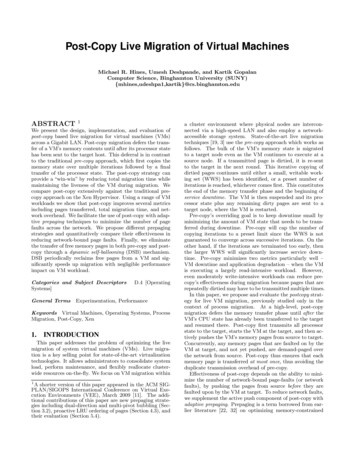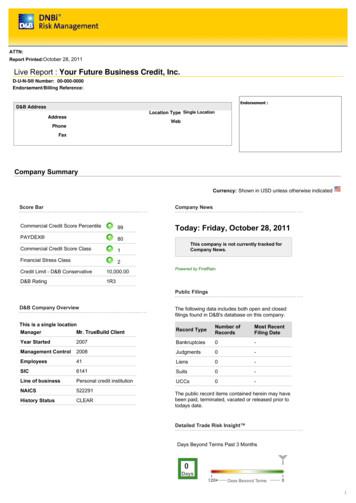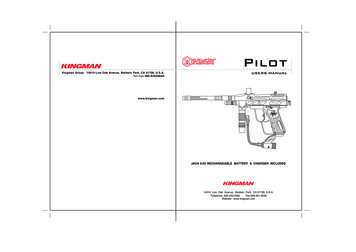
Transcription
Post-Copy Live Migration of Virtual MachinesMichael R. Hines, Umesh Deshpande, and Kartik GopalanComputer Science, Binghamton University STRACT1We present the design, implementation, and evaluation ofpost-copy based live migration for virtual machines (VMs)across a Gigabit LAN. Post-copy migration defers the transfer of a VM’s memory contents until after its processor statehas been sent to the target host. This deferral is in contrastto the traditional pre-copy approach, which first copies thememory state over multiple iterations followed by a finaltransfer of the processor state. The post-copy strategy canprovide a “win-win” by reducing total migration time whilemaintaining the liveness of the VM during migration. Wecompare post-copy extensively against the traditional precopy approach on the Xen Hypervisor. Using a range of VMworkloads we show that post-copy improves several metricsincluding pages transferred, total migration time, and network overhead. We facilitate the use of post-copy with adaptive prepaging techniques to minimize the number of pagefaults across the network. We propose different prepagingstrategies and quantitatively compare their effectiveness inreducing network-bound page faults. Finally, we eliminatethe transfer of free memory pages in both pre-copy and postcopy through a dynamic self-ballooning (DSB) mechanism.DSB periodically reclaims free pages from a VM and significantly speeds up migration with negligible performanceimpact on VM workload.Categories and Subject DescriptorsSystems]General TermsD.4 [OperatingExperimentation, PerformanceKeywords Virtual Machines, Operating Systems, ProcessMigration, Post-Copy, Xen1.INTRODUCTIONThis paper addresses the problem of optimizing the livemigration of system virtual machines (VMs). Live migration is a key selling point for state-of-the-art virtualizationtechnologies. It allows administrators to consolidate systemload, perform maintenance, and flexibly reallocate clusterwide resources on-the-fly. We focus on VM migration within1A shorter version of this paper appeared in the ACM SIGPLAN/SIGOPS International Conference on Virtual Execution Environments (VEE), March 2009 [11]. The additional contributions of this paper are new prepaging strategies including dual-direction and multi-pivot bubbling (Section 3.2), proactive LRU ordering of pages (Section 4.3), andtheir evaluation (Section 5.4).a cluster environment where physical nodes are interconnected via a high-speed LAN and also employ a networkaccessible storage system. State-of-the-art live migrationtechniques [19, 3] use the pre-copy approach which works asfollows. The bulk of the VM’s memory state is migratedto a target node even as the VM continues to execute at asource node. If a transmitted page is dirtied, it is re-sentto the target in the next round. This iterative copying ofdirtied pages continues until either a small, writable working set (WWS) has been identified, or a preset number ofiterations is reached, whichever comes first. This constitutesthe end of the memory transfer phase and the beginning ofservice downtime. The VM is then suspended and its processor state plus any remaining dirty pages are sent to atarget node, where the VM is restarted.Pre-copy’s overriding goal is to keep downtime small byminimizing the amount of VM state that needs to be transferred during downtime. Pre-copy will cap the number ofcopying iterations to a preset limit since the WWS is notguaranteed to converge across successive iterations. On theother hand, if the iterations are terminated too early, thenthe larger WWS will significantly increase service downtime. Pre-copy minimizes two metrics particularly well –VM downtime and application degradation – when the VMis executing a largely read-intensive workload. However,even moderately write-intensive workloads can reduce precopy’s effectiveness during migration because pages that arerepeatedly dirtied may have to be transmitted multiple times.In this paper, we propose and evaluate the postcopy strategy for live VM migration, previously studied only in thecontext of process migration. At a high-level, post-copymigration defers the memory transfer phase until after theVM’s CPU state has already been transferred to the targetand resumed there. Post-copy first transmits all processorstate to the target, starts the VM at the target, and then actively pushes the VM’s memory pages from source to target.Concurrently, any memory pages that are faulted on by theVM at target, and not yet pushed, are demand-paged overthe network from source. Post-copy thus ensures that eachmemory page is transferred at most once, thus avoiding theduplicate transmission overhead of pre-copy.Effectiveness of post-copy depends on the ability to minimize the number of network-bound page-faults (or networkfaults), by pushing the pages from source before they arefaulted upon by the VM at target. To reduce network faults,we supplement the active push component of post-copy withadaptive prepaging. Prepaging is a term borrowed from earlier literature [22, 32] on optimizing memory-constrained
disk-based paging systems. It traditionally refers to a moreproactive form of pre-fetching from storage devices (suchas hard disks) in which the memory subsystem can try tohide the latency of high-locality page faults by intelligentlysequencing the pre-fetched pages. Modern virtual memorysubsystems do not typically employ prepaging due increasing DRAM capacities. Although post-copy doesn’t deal withdisk-based paging, the prepaging algorithms themselves canstill play a helpful role in reducing the number of networkfaults in post-copy. Prepaging adapts the sequence of actively pushed pages by using network faults as hints to predict the VM’s page access locality at the target and activelypush the pages in the neighborhood of a network fault before they are accessed by the VM. We propose and comparea number of prepaging strategies for post-copy, which wecall bubbling, that reduce the number of network faults tovarying degrees.Additionally, we identified a deficiency in both pre-copyand post-copy migration due to which free pages in the VMare also transmitted during migration, increasing the totalmigration time. To avoid transmitting the free pages, wedevelop a “dynamic self-ballooning” (DSB) mechanism. Ballooning is an existing technique that allows a guest kernelto reduce its memory footprint by releasing its free memorypages back to the hypervisor. DSB automates the ballooning mechanism so it can trigger periodically (say every 5 seconds) without degrading application performance. Our DSBimplementation reacts directly to kernel memory allocationrequests without the need for guest kernel modifications. Itneither requires external introspection by a co-located VMnor excessive communication with the hypervisor. We showthat DSB significantly reduces total migration time by eliminating the transfer of free memory pages in both pre-copyand post-copy.The original pre-copy algorithm has advantages of its own.It can be implemented in a relatively self-contained externalmigration daemon to isolate most of the copying complexityto a single process at each node. Further, pre-copy also provides a clean way to abort the migration should the targetnode ever crash during migration because the VM is stillrunning at the source. (Source node failure is fatal to bothmigration schemes.) Although our current post-copy implementation cannot recover from failure of the target nodeduring migration, we discuss approaches in Section 3.4 bywhich post-copy could potentially provide the same level ofreliability as pre-copy.We designed and implemented a prototype of the postcopy live VM migration in the Xen VM environment. Throughextensive evaluations, we demonstrate situations in whichpost-copy can significantly improve performance in terms oftotal migration time and pages transferred. We note thatpost-copy and pre-copy complement each other in the toolbox of VM migration techniques available to a cluster administrator. Depending upon the VM workload type andperformance goals of migration, an administrator has theflexibility to choose either of the techniques. For VMs withread-intensive workloads, pre-copy would be the better approach whereas for large-memory or write-intensive workloads, post-copy would better suited. Our main contribution is in demonstrating that a post-copy based approach ispractical for live VM migration and to evaluate its meritsand drawbacks against the pre-copy approach.2. RELATED WORKProcess Migration: The post-copy technique has beenvariously studied in the context of process migration literature: first implemented as “Freeze Free” using a fileserver [26], then evaluated via simulations [25], and later viaactual Linux implementation [20]. There was also a recentimplementation of post-copy process migration under openMosix [12]. In contrast, our contributions are to develop aviable post-copy technique for live migration of virtual machines. Process migration techniques in general have beenextensively researched and an excellent survey can be foundin [17]. Several distributed computing projects incorporateprocess migration [31, 24, 18, 30, 13, 6]. However, thesesystems have not gained widespread acceptance primarilybecause of portability and residual dependency limitations.In contrast, VM migration operates on whole operating systems and is naturally free of these problems.PrePaging: Prepaging is a technique for hiding the latency of page faults (and in general I/O accesses in the critical execution path) by predicting the future working set [5]and loading the required pages before they are accessed.Prepaging is also known as adaptive prefetching or adaptive remote paging. It has been studied extensively [22, 33,34, 32] in the context of disk based storage systems, sincedisk I/O accesses in the critical application execution pathcan be highly expensive. Traditional prepaging algorithmsuse reactive and history based approaches to predict andprefetch the working set of the application. Our system employs prepaging, not in the context of disk prefetching, butfor the limited duration of live VM migration to avoid thelatency of network page faults from target to source. Ourimplementation employs a reactive approach that uses anynetwork faults as hints about the VM’s working set withadditional optimizations described in Section 3.1.Live VM Migration. Pre-copy is the predominant approach for live VM migration. These include hypervisorbased approaches from VMware [19], Xen [3], and KVM [14],OS-level approaches that do not use hypervisors from OpenVZ[21], as well as wide-area migration [2]. Self-migration of operating systems (which has much in common with processmigration) was implemented in [9] building upon prior work[8] atop the L4 Linux microkernel. All of the above systems currently use pre-copy based migration and can potentially benefit from the approach in this paper. The closestwork to our technique is SnowFlock [15]. This work sets upimpromptu clusters to support highly parallel computationtasks across VMs by cloning the source VM on the fly. Thisis optimized by actively pushing cloned memory via multicast from the source VM. They do not target VM migration in particular, nor present a comprehensive comparisonagainst (or optimize upon) the original pre-copy approach.Non-Live VM Migration. There are several non-liveapproaches to VM migration. Schmidt [29] proposed using capsules, which are groups of related processes alongwith their IPC/network state, as migration units. Similarly,Zap [23] uses process groups (pods) along with their kernel state as migration units. The Denali project [37, 36]addressed migration of checkpointed VMs. Work in [27] addressed user mobility and system administration by encapsulating the computing environment as capsules to be transferred between distinct hosts. Internet suspend/resume [28]focuses on saving/restoring computing state on anonymoushardware. In all the above systems, the VM execution sus-
pended and applications do not make progress.Dynamic Self-Ballooning (DSB): Ballooning refers toartificially requesting memory within a guest kernel and releasing that memory back to the hypervisor. Ballooningis used widely for the purpose of VM memory resizing byboth VMWare [35] and Xen [1], and relates to self-paging inNemesis [7]. However, it is not clear how current ballooningmechanisms interact, if at all, with live VM migration techniques. For instance, while Xen is capable of simple one-timeballooning during migration and system boot time, there isno explicit use of dynamic ballooning to reduce the memoryfootprint before live migration. Additionally, self-ballooninghas been recently committed into the Xen source tree [16]to enable a guest kernel to dynamically return free memory to the hypervisor without explicit human intervention.VMWare ESX server [35] includes dynamic ballooning andidle memory tax, but the focus is not on reducing the VMfootprint before migration. Our DSB mechanism is similar in spirit to the above dynamic ballooning approaches.However, to the best of our knowledge, DSB has not beenexploited systematically to date for improving the performance of live migration. Our work uses DSB to improve themigration performance of both the pre-copy and post-copyapproaches with minimal runtime overhead.3.DESIGNIn this section we present the design of post-copy live VMmigration. The performance of any live VM migration strategy could be gauged by the following metrics.1. Preparation Time: This is the time between initiating migration and transferring the VM’s processorstate to the target node, during which the VM continues to execute and dirty its memory. For pre-copy,this time includes the entire iterative memory copyingphase, whereas it is negligible for post-copy.2. Downtime: This is time during which the migratingVM’s execution i
copy’s effectiveness during migration because pages that are repeatedly dirtied mayhave tobe transmittedmultiple times. In this paper, we propose and evaluate the postcopy strat-egy for live VM migration, previously studied only in the context of process migration. At a high-level, post-copy migration defers the memory transfer phase until after the VM’s CPU state has already been .











